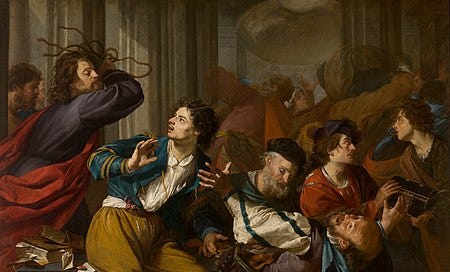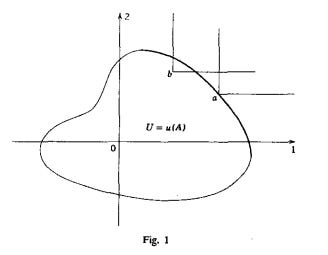Reading Length: 15 Minutes
Key-Words: Market Design, Resource Allocation, Non-Profits, Economics
It is a cliché in economics that markets are efficient institutions for allocating resources. This is generally taken as an article of faith by those not educated in economics (or disputed as an article of faith). So what does this claim actually mean?
By efficient, it is meant that those who produce goods in the best manner will provide those goods to consumers who value them the most. Welfare economists showed that under a certain set of assumptions, markets will move towards an equilibrium in which there is not a different outcome that could make a participant better off without making another worse off.1 This outcome is called Pareto optimality, after an Italian economist that worked on the equilibrium models in the early 20th century.
It was mathematically proven that markets led to Pareto optimality under a certain set of conditions, but it was left under-examined how to engender these conditions in the first place and what happened when the conditions broke down.2 This led economists to the issues of market structure and market design, which remain fruitful research agendas today.
Ronald Coase, in a landmark 1960 paper, showed how individuals would come together to bargain over property disputes in a Pareto optimal manner.3 So long as property rights were already prescribed and individuals were able to bargain, legal judges would not have to worry about choosing a socially ideal winner and loser in lawsuits, but instead could focus on issues of individual fairness. The upshot of ‘Coase’s Theorem’ is that rather than meddling in markets, governments should ensure that transaction costs are low, meaning that it is easy for individuals to bargain in a market-like structure.
It is always possible to modify by transactions on the market [after] the initial legal delimitation of rights. And, of course, if such market transactions are costless, such a rearrangement of rights will always take place if it would lead to an increase in the value of production.
Hayek, a 20th-century economist of the Austrian School, achieved widespread fame for focusing on the role of information in resource allocation. As Hayek saw it, markets outperformed centralized decision-makers because information was costly to aggregate.4 As a well-known passage states:
The peculiar character of the problem of a rational economic order is determined precisely by the fact that the knowledge of the circumstances of which we must make use never exists in concentrated or integrated form but solely as the dispersed bits of incomplete and frequently contradictory knowledge which all the separate individuals possess. The economic problem of society is thus not merely a problem of how to allocate “given” resources—if “given” is taken to mean given to a single mind which deliberately solves the problem set by these “data.” It is rather a problem of how to secure the best use of resources known to any of the members of society, for ends whose relative importance only these individuals know. Or, to put it briefly, it is a problem of the utilization of knowledge which is not given to anyone in its totality.
Hayek claims that the mathematical models of the welfare economists obscured the difficulty of aggregating partial information from participants in a market. Markets cannot be replaced by an omniscient central planner because it is exactly the interaction of imperfect participants that aggregates the information necessary to clear the market:
To assume all the knowledge to be given to a single mind in the same manner in which we assume it to be given to us as the explaining economists is to assume the problem away and to disregard everything that is important and significant in the real world.
To outperform a market at allocating resources under ideal conditions, a central planner would not only have to aggregate all the information necessary, but do so at such a low cost that it can still be more efficient.5 This would be a paradox, however, because if ideal conditions are already assumed than any cost of information, no matter how low, will still make the central planner more inefficient.
A case study from a recent market innovation will help illustrate this problem.
Feeding America
Feeding America is a nonprofit that coordinates the distribution of over 300 million pounds of food per year to regional food banks. Feeding America helps feed over 46 million people through its network of over 200 food banks and is ranked as the second largest US charity by revenue.6
Prior to 2005, Feeding America had a crude system for matching food banks with food donors (typically large corporations like Walmart that has extra food to donate). This was described as a simple “wait-your-turn” system:
The queue was determined by the amount of food that a food bank had received compared to a measure of need called the “Goal Factor,” which is (roughly) the number of poor in a food bank’s area compared to the national average.
While the system could account for relative need between food banks, its simplicity created a lot of inefficiencies in the distribution of the food. First, the food was offered as a simple lot, with little description in detail of what kind of food was being donated. Because the system was a queue, if a food bank turned down a food donation, it gave up its spot and moved to the end of the queue. Furthermore, Pendergast highlights two specific problems:
First, a food bank might get food that a different food bank values more. If a food bank already has enough for its clients at a point in time, any extra may even go to waste.
This problem was exacerbated by the fact that food banks did not just get food from Feeding America, but a handful of other sources as well. Overall, Feeding America counts for only 25% of food distribution to food banks. In this system, Feeding America has no knowledge on the other 75% of goods that are distributed to food banks, otherwise it could allocate the resources more efficiently.
For example, if potatoes were being donated, and Feeding America already knew that a food bank had received potatoes from a different source, it could target a food bank low on potatoes to skip the queue.
The second problem with the old queueing system is that Feeding America could only offer food to one food bank at a time.
This is a problem because many types of food spoil. If the first food bank in the queue passes, the option goes to the second. But the second food bank has a handful of hours to check their storage and delivery capabilities. In the meantime, the food is spoiling.
This process implied that Feeding America could only offer the load to a small number of food banks before either the donor would become upset over the load being left on its dock for a long time, or the food would spoil.
Markets as a Solution
These problems led Feeding America to work with a group of economists to design a better system for allocating the food resources. The economists, which included Pendergast, believed that a pseudo-market could fix the issues. The market would be psuedo because the currency would be make-believe, essentially monopoly money.
Instead of a queue system, food banks would use their virtual, worthless currency to bid on the food donations as they became available. They titled this the 'Choice Program'.7
Orthodox economists would predict that the market mechanism has potential to dramatically reduce the inefficiencies in the system. But they would be careful to caveat that markets only work well in specific conditions, and have to be designed carefully to ensure these conditions inhere.
Market Design
The economist most well-known for studying market design is probably Alvin Roth, who shared the 2012 Nobel Memorial Prize with Shapley for his work on markets. In a 2012 article titled ‘What Have We Learned from Market Design?’, Roth lays out a few features that markets need to have to perform well.8
…marketplaces need to
provide thickness - that is, they need to attract a sufficient proportion of potential market participants to come together ready to transact with one another.
overcome the congestion that thickness can bring, by providing enough time, or by making transactions fast enough, so that market participants can consider enough alternative possible transactions to arrive at satisfactory ones.
make it safe to participate in the market as simply as possible
(a) as opposed to transacting outside of the marketplace, or
(b) as opposed to engaging in strategic behavior that reduces overall welfare
…
Some kinds of transactions are repugnant, and this can be an important constraint on market design
So to predict how well the Choice Program would perform, we must consider the issues of thickness, congestion, safety, and repugnancy.
A Repugnant Conclusion
Starting backwards, the issue of repugnancy immediately presented itself. Pendergast quotes one of the members of the redesign committee, a regional food bank director:
I am a socialist . That’s why I run a food bank. I don’t believe in markets. I’m not saying I won’t listen, but I am against this.
The idea of a market itself was repugnant to some participants. As the project progressed, however, the economists discovered that food bank directors were more concerned that the market would unfairly favor large banks over small banks. By demonstrating that there were market safeguards to protect small banks, these resistors were gradually won over.
What were some of these safeguards? First, initial currency budgets were allotted along the same basis of the previous Goal Factor system, so that food banks with greater needs received more currency every day than food banks with less need.
Second, there was a credit system so that food banks with small budgets could borrow extra currency, at no interest cost, to afford more expensive food. Third, fractional bidding was introduced so that small banks could band together and bid for food to split accordingly between them, which was not possible under the old system.
Fourth, there was a Fairness and Equity Committee that could be appealed to and overrule market decisions if participants felt aggrieved. These safeguards helped reduce the initial repugnancy of the idea of a food bank market.
Market Safety
Would food banks feel safe participating in this market? Would they even know how?
A concern was that some food banks—again most likely the smaller ones—would find bidding so intimidating that they would largely withdraw from the allocation process.
To address this concern, the economists did a few things. First, the bidding system was first rolled out in beta, where food banks could practice bidding without any real outcomes occurring. Second, food banks could elect to have a Feeding America employee place bids for them, after outlining some general preferences for food. Third, the auctions are blind, meaning no one can see anyone else’s bid, which prevents any market participant from waiting until the last second and ‘sniping’ a bid by a fraction.
These market design features helped ensure that the food banks would feel safe participating. After all, the food banks could always decrease the amount of food they got from Feeding America and try to increase other avenues of distribution.
Congested Markets
Markets should not be too fast or too slow. If goods move too fast, the food banks would not have enough time to adequately determine how much they wanted that particular donation, and how to arrange transportation to retrieve the food. If goods move too slow, there would not be much incentive to participate in the market and bids could fall apart as food banks change their mind.
To help prevent market congestion, the Choice Program holds a twice-daily blind auction that closes at exactly 12pm and 4pm CST. Food donations must be posted to the market at least two hours before close. This ensures that food banks know exactly what time transactions will close so they can plan accordingly, and the two-hour rule prevents any food donors forcing food banks to make split-second decisions.
Market Thickness
Would people actually participate in the market? Considering that Feeding America accounted for 25% of food banks sourcing, they had considerable power to incentive food banks to play along. If they only accounted for 3-5%, it would be unlikely that market thickness would result because it would probably not be worth it for the typically under-resourced local food banks to learn how to participate in the new market system.
Results
Considering the attention to detail that went into the market design of the Choice Program, it would be reasonable to predict that the market did its job at outperforming the old queue system. The economists tracked data both before and after implementation of the Choice Program to properly assess the new design, from 1999 to 2011.
The most immediate outcome of a market is the price system. Before, Feeding America could not ascertain how much food banks valued certain types of goods over others. With the Choice Program, all they had to do was look at the prices:
Of course, the ‘price’ is irrelevant because it is a made-up currency. What actually matters is the ratio between goods that the price shows.
To put this concretely, a food bank can buy 49 pounds of produce for the price of a single pound of cereal.
It is obvious that these prices do not reflect the ‘true’ supermarket prices of food. What they do reflect is the marginal demand that food banks have for certain types of goods. If food banks receive copious amounts of produce as donations, but barely any cereal, then it is not surprising that food banks will want more cereal to balance out the disparity with produce. It could also be reflective of the fact that produce is less desirable because it can spoiler faster.
Even before considering allocative efficiency, this is already helpful information to Feeding America because they can pass on the higher demand for cereal and diapers to their corporate partners.
Allocative Efficiency
One way to consider the efficiency of the Choice Program is to split the goods up into “high-quality” and “low-quality” based on their price. So diapers would be high and drinks would be low quality.
In the old system, food banks did not have much of an ability to discriminate between high and low quality goods in the queue system. Under the Choice Program, however, the food banks can purchase whatever they want. Predictably, food banks that are less dependent on Feeding America will purchase more high-quality food, since they can be pickier thanks to their already-stuffed storage. Conversely, food banks that are more dependent on Feeding America would want to buy lower-quality food so that they can fill up their storage with stable foods.
In other words, the market acts as an automatic equalizer that naturally guides food to where it is most wanted. Food banks that are excited about the prospects of getting juice can purchase that cheaply, while food banks that already have too much juice can opt into receiving a different mix of food.
To be clear, the food is not labeled low-quality because it is literally bad or unhealthy, but simply because it is not demanded as highly by food banks due to the fact that some of them already receive enough of that type of food from other sources.
In the period from 2005 to 2011, food-poor food banks received 400,000 extra pounds of low-quality food per year in exchange for getting 60,000 less pounds of high-quality food. Overall, however, the food-poor food banks actually increased the amount of total food they could get.
The food poor receive 66 percent more inexpensive food and 10 percent more expensive food.
After looking at the data, Pendergast concludes:
In this way, the Choice Program has had the effect of redistributing resources to the neediest areas of the country, which some of the food bank directors both noticed and appreciated.
Revisiting Market Design
How well did the Choice Program address the key market design issues Roth lays out: thickness, congestion, safety, and repugnancy.
The skeptical ‘socialist’ quoted earlier “eventually became one of the most ardent users and supporters of the system, and focused his purchases on the less-expensive items.”
The market safeguards, such as the option to have a Feeding America employee submit bids or appealing to the Fairness and Equity Committee, were scarcely used. Some food banks opted to have Feeding America proxy their bids when key employees went on vacation, and not a single appeal was submitted to the committee.
The combination of credit use, joint-bidding, and the absence of any need for Feeding America to intervene either to fix problems or to bid for the food banks strongly suggests that any concern that “small guys” would be disadvantaged has been alleviated.
A Road Not Travelled
Instead of opting for a market mechanism, why did Feeding America not choose instead to implement a more sophisticated central planning system? For example, food banks could submit their needs to Feeding America every day, and Feeding America could use an algorithm, such as linear programming, to efficiently allocate the food donations across the food banks.
While this option is not discussed in Pendergast’s paper, there are a number of concerns that could arise with such a structure. First, the food banks would have to be able to accurately determine their needs across the entire spectrum of food options daily, instead of simply determining if a food auction is worth bidding on as it arises. This cost of information could be overly burdensome for the small food banks.
Second, food banks could face perverse incentives to ‘game the system’ and submit dishonest amounts to Feeding America. This was a common critique of the Soviet style of economic planning. Factory managers, when submitting their predicted needs and output to Gosplan planners, would be overpessimistic about how much input they needed and overoptimistic about how much they could actually produce. In terms of Roth’s game theory language, this type of system is not strategy-proof. Participants have adverse incentives to reveal their true preferences, leading inevitably to an inefficient outcome.
Limits of Markets
It is interesting that markets can reveal preferences and lead to efficient outcomes, even in the case where currencies are make-believe. Pendergast concludes her paper by noting that there were several unique features of the Feeding America context that lent itself to a market solution. Free-market ideologues should not take away the lesson that markets will always and everywhere lead to better outcomes:
It is probably best to view the experience of Feeding America with the Choice Program not as a victory for markets per se, but rather as an illustration of how a flexible choice-revealing allocation system can be combined with a myriad of small details that include a focus on equity concerns.
In 2021 Mike Konczal wrote ‘Freedom from the Market’, imploring readers to consider when markets work in the favor of everyday Americans and when they don’t.
A free society will provide key goods in some realms and suppress markets in others. Sometimes this can be done with regulations and mandates, while other times it must be through the public directly providing the good itself.
The bare existence of food banks themselves suggests that the American economy leaves a lot to be desired when it comes to allocative efficiency.
The term welfare is confusing here because welfare in vernacular is associated with government support programs, whereas welfare economists are interested in how markets come to maximize *welfare* as a term of utility. Welfare economists, somewhat ironically, legitimized laissez-faire political programs, although a handful of welfare economists such as Arrow, Koopmans, and Lerner had socialist sympathies.
For one of the most famous expositions of market equilibrium, see Gerard Debreu’s ‘Theory of Value’, 1959, available online here. Market equilibriums had been a white whale for economists dating back to the 19th century. Walras, Pareto, Marshall, and others tried to prove market optimality using calculus, but they could only prove that equilibrium was a local optima rather than a global maxima. Debreu, Arrow, Wald, Von Neumann, Koopmans, and others in the second half of the 20th century used new mathematical methods in topology to prove definitively that equilibria were optimal.
Ronald Coase, ‘The Problem of Social Cost’, 1960. Technically, Pareto optimality is only achieved in the impossible situation where transaction costs are 0, but optimality is approached as transaction costs fall.
Ideal conditions never cohere in the real world. There are therefore many scenarios where a central planner can still outcompete a market mechanism at allocating resources. For a famous example, see Kenneth Arrow, ‘Uncertainty and the Welfare Economics of Medical Care’, 1963.
This information, and the rest of the article more broadly, is summarized from Canice Prendeergast, ‘How Food Banks Use Markets to Feed the Poor’, 2017.
The currency is of course not worthless in the sense that it is used by the food banks to bid on food. It is worthless because any attempt to convert it to a fiat currency or transact for goods outside of the internal pseudo-market is prohibited.








